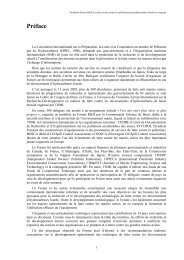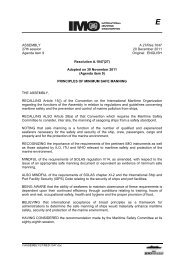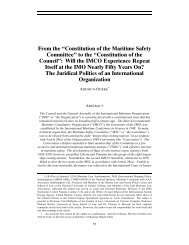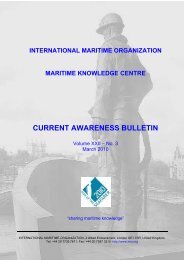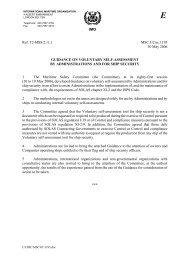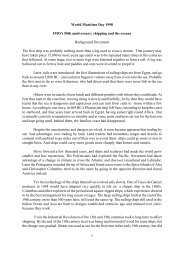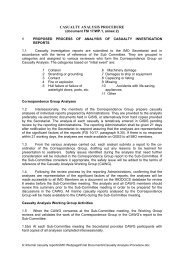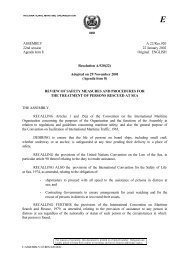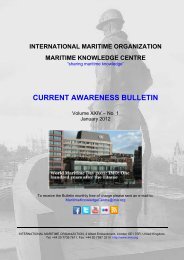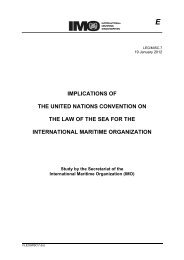Radioactive Waste Disposal at Sea: Public Ideas ... - IMO
Radioactive Waste Disposal at Sea: Public Ideas ... - IMO
Radioactive Waste Disposal at Sea: Public Ideas ... - IMO
You also want an ePaper? Increase the reach of your titles
YUMPU automatically turns print PDFs into web optimized ePapers that Google loves.
Chapter 8<br />
Notes to pp. 131–134 221<br />
1. For the situ<strong>at</strong>ion of those four n<strong>at</strong>ions <strong>at</strong> the time, see table 2.3.<br />
2. Pro-dumping and anti-dumping governments had l<strong>at</strong>er been unable to reach an<br />
agreement <strong>at</strong> a 1966 meeting held in Lisbon. See van Weers et al. 1982, p. 451.<br />
3. These shipments and the subsequent storage of plutonium in Japan caused (and<br />
still cause) considerable domestic and intern<strong>at</strong>ional controversy. See O’Neill 1999.<br />
4. “Mariana Islanders Protest Plans By Japan to Dump Atomic <strong>Waste</strong>,” New York<br />
Times, August 3, 1980; Van Dyke et al. 1984, p. 742; Branch 1984, pp. 329–330.<br />
5. Plans by the United St<strong>at</strong>es will be discussed below.<br />
6. See also “Japan: <strong>Sea</strong>bed Dumping Delayed as Other N<strong>at</strong>ions Object,” Nuclear<br />
News 24, March 1981, 61–62.<br />
7. Japan’s desire to act in a responsible way intern<strong>at</strong>ionally motiv<strong>at</strong>ed this and l<strong>at</strong>er<br />
decisions on the issue (interview, Takao Kuramochi, August 30, 1991). This consider<strong>at</strong>ion<br />
might have been given some weight by Japanese governments as the<br />
United St<strong>at</strong>es had urged Japan to join, or even provide intern<strong>at</strong>ional leadership<br />
behind, efforts to protect the environment; see, e.g., Friedman 1991. In 1980, however,<br />
Japanese fishermen, fearing adverse effects from dumping on the fish stocks<br />
th<strong>at</strong> constituted their livelihood, thre<strong>at</strong>ened to use their bo<strong>at</strong>s to hinder dumping;<br />
see Trumbull 1980; see also Junkerman 1981, p. 32. At the same time, the government<br />
of the Commonwealth of the Northern Marianas reportedly warned th<strong>at</strong><br />
Japanese vessels would be excluded from its fishing zone should dumping oper<strong>at</strong>ions<br />
be commenced; see Finn 1983b, p. 216. The following consider<strong>at</strong>ions have<br />
also been suggested to explain Japan’s decision not to dump: “Japan has been cultiv<strong>at</strong>ing<br />
an image of peace and concili<strong>at</strong>ion in an effort to live down its prewar reput<strong>at</strong>ion<br />
as the Pacific Basin’s strong-arm bully; [and] it has made substantial<br />
investments in the island n<strong>at</strong>ions and territories, and wants to make more.” (Carter<br />
1987, p. 364)<br />
8. In 1980, officials of the Japanese Science and Technology Agency noted it was<br />
still “not necessary to get approval of foreign governments” (Kirk 1980, p. 4). In<br />
1981, a leading official of the same agency reportedly (Kamm 1981) said: “We will<br />
continue to have a plan to dump. We did not give up the plan.”<br />
9. See also Bakalian 1984.<br />
10. See also Shabecoff 1982.<br />
11. In 1982, the Department of Energy estim<strong>at</strong>ed th<strong>at</strong> land disposal of 60,000 metric<br />
tons of slightly radioactive soil would cost well over $100 million, but ocean disposal<br />
less than $10 million. See Roberts 1982, p. 774. In 1984, it was estim<strong>at</strong>ed<br />
th<strong>at</strong> dumping nine retired submarines would cost about $5.2 million, whereas burying<br />
them on land would cost $13.3 million (Trupp 1984, p. 34). Both of the Navy’s<br />
cost estim<strong>at</strong>es (which did not include the costs of monitoring over a period of several<br />
hundred years, and which presented scientific document<strong>at</strong>ion claiming th<strong>at</strong> no<br />
harm would be inflicted on the marine environment and human health) were criticized<br />
by U.S. groups opposing the Navy’s plans. See “Joint Comments of Environmental<br />
and Other Citizen Organiz<strong>at</strong>ions in Response to the Department of Navy’s




